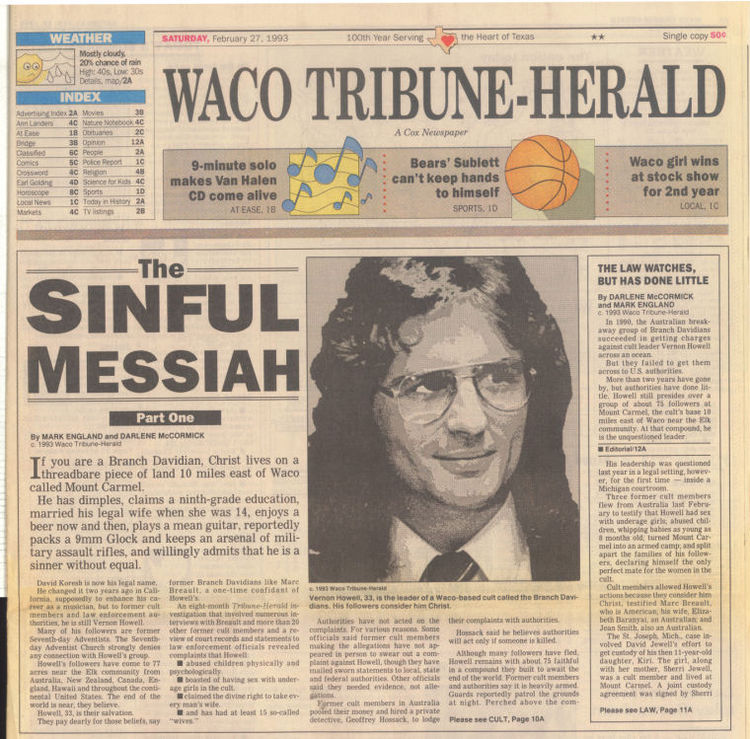
On February 27, 1993, the Waco Tribune-Herald ran the first installment of a monstrously libelous exposè on the Branch Davidians, accusing David Koresh of a catalog of crimes. The drumbeat continued through the weeks of the siege with six more installments until even those who defended the Davidians' civil rights were ashamed to speak. Click to enlarge. Full series available in Waco Tribune-Herald archive. |
History shows that people do not normally seek to rend each other into bloody rags. This has been a problem (shall we say) for rulers throughout the centuries: How can the king arouse that special feeling among the citizenry that will make them go on a murderous rampage — or permit the king to send troops (of social misfits) on such enterprises in their name?
In some ways, such propaganda can be compared to a war dance practiced by stone-age peoples. Instead of holding a dance to get the warriors in the mood for war, the tribal/political leaders recite horrific stories of the enemies until the warriors are maddened beyond reason.
A survey of history reveals a limited number of devices have been repeatedly successful:
- Empire and riches. People (such as the Vikings, the Mongols, and the European warrior-explorers) can be persuaded to kill, rob, and pillage if great plunder and rewards are promised.
- Religion. If the people believe a god or gods have promised special favor
or immortality, they will sometimes undertake war. God is, after all, on our
side. In one special case, the Hebrews were also told that Jehovah would punish
them with terrible suffering if they did not exterminate all the Gentiles in the
Promised Land (according to Biblical History). Numbers 33:
- Speak unto the children of Israel, and say unto them, When ye are passed over Jordan into the land of Canaan;
- Then ye shall drive out all the inhabitants of the land from before you, and destroy all their pictures, and destroy all their molten images, and quite pluck down all their high places:
- And ye shall dispossess the inhabitants of the land, and dwell therein: for I have given you the land to possess it.
- …
- But if ye will not drive out the inhabitants of the land from before you; then it shall come to pass, that those which ye let remain of them shall be pricks in your eyes, and thorns in your sides, and shall vex you in the land wherein ye dwell.
- Moreover it shall come to pass, that I shall do unto you, as I thought to do unto them.
- Defense or Vengeance. If a people believe they are in grave danger, they will of course take up arms. Even if they believe the danger is passed, they will often go to war to punish a great wrong they believe they have suffered.
- Monstrosity and Evil. If people believe that a great evil needs to be eliminated from the face of the earth and only war can do it, they will willingly answer the call. This may be seen as a combination of devices 2 and 3, above.
For example, the ancient Jehovah justified his command to the Hebrews to exterminate the Gentiles with allegations that the Gentiles sacrificed their children to the idol, Moloch. Critical thinking would suggest that the extermination could be more easily accomplished just by encouraging the Gentiles to hold more child sacrifices, not fewer. But critical thinking is rarely applied to war propaganda.
Wikipedia uses the phrase "atrocity propaganda" and cites a number of examples from the two great wars. In our own time, the US Congress considered seriously accusations that premature babies in Kuwait were being thrown out of incubators by Iraqi soldiers to die on the floor—accusations fabricated by the PR firm Hill & Knowlton (CBC-TV program called To Sell a War). Later, the US military claimed the Iraqis were building and stockpiling weapons of mass destruction (WMD) for use on Western countries, while the ruler Saddam Hussein ran his political enemies through shredders and wood chippers. None of it was factual, but after the war is fought and the fever has cooled, the lies are forgotten and the liars are rarely punished — because their work is blessed by the thrones of power.
Instilling war fever in a target population is a specialty that is now called "Psychological Operations." In modern times, it operates primarily through the (so-called) news media.
Now let us look at the events surrounding the attack and siege on Mt. Carmel. On February 27, 1993, the Waco Tribune-Herald ran the first installment of a monstrously libelous exposè on the Branch Davidians, accusing David Koresh of a catalog of crimes. The drumbeat continued through the weeks of the siege with six more installments, until even those who defended the Davidians' civil rights were ashamed to speak. Simultaneously, The Dallas Daily News kept a running barrage of accusations. David Koresh was said to be a polygamist, child abuser, self-appointed Messiah; he was accused of claiming to be Jesus Christ, of misinterpreting the Bible, manufacturing machine guns, stock-piling military weapons, training his followers in military tactics, planning an armed attack on the people of Waco, and priming his followers for mass suicide, a la the Jonestown affair.
Police organizations (ATF, FBI, state, or local) do not normally bother with psychological operations, nor do they advertise their accusations flamboyantly in front page exposès. Likewise, newspapers do not normally take the risk of accusing people of terrible crimes, such as child abuse, without a careful phrasing of deniability.
The "Sinful Messiah" series was a remarkable exception. No newspaper publishes so damning a personal attack on a private person without solid evidence, yet the Tribune-Herald accused Koresh with abandon, as though the editors knew they would never stand trial for libel. In retrospect, the "Sinful Messiah" series was an attestation of editorial certainty that the subject of the libel (Koresh) would not survive to take the Tribune-Herald to court.
The Sinful Messiah is often mentioned as a defining moment for the Waco Tribune-Herald, which still features the series on its webpage.
Meanwhile, The Dallas Morning News published update articles every day. The updates emphasized the following points:
- Most of the Davidians were alive throughout the siege;
- The government was being exceptionally reasonable;
- Koresh and his followers were crazy criminals with dangerous weapons.
The Dallas Morning News collected most of the stories on the massacre in an archive that was available for a few years on the Internet. The archive was then removed and not available anywhere. The Museum now makes that collection available to the public.
Propaganda from The Dallas Morning News and the Waco Tribune-Herald was picked up by Associated Press (and other news wires) and republished throughout the world. (E.g., The Spokesman-Review (Spokane, Washington), April 20, 1993)
Throughout the siege, the federal agencies' allegations of Koresh's violent nature and intentions were used to justify extreme and deadly force.
The psychological operation was a success. Here was a group home of a dozen families attacked, imprisoned, tortured, and finally killed during weeks of round-the-clock TV coverage without the slightest interference. Shades of the tales of the "Good Germans" who lived close to the extermination camps, knew what was happening, and did nothing.
The allegations of child abuse were never substantiated
Questions about child abuse remained unresolved as Texas officials reported Friday that they had never substantiated a child abuse allegation at the compound. (The Washington Post: April 25, 1993, cached)
FBI officials, in Waco to manage the siege, later said they had no proof that child abuse was going on during the standoff but had historical accounts of alleged abuse (The Dallas Morning News, May 5, 1993).
All were innocent before the law
War propaganda may be divided into two distinct campaigns.
The first vilifies and dehumanizes the enemy so that people of good intent are nevertheless moved to destructive and murderous war. But afterward, the public may reconsider and suffer remorse, a possibility the propagandist must prevent.
Therefore, when the action is over, the propagandist must again go to work to seal the deal, to shape the narrative forever after.
This is a survey of how American media giants justified putting to death more than 80 souls without trial—all of whom were innocent before the law.
| Click on the image to view full size | ||
|---|---|---|
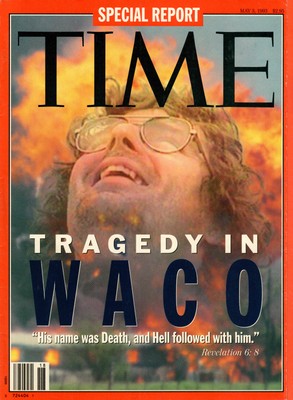
Cover of Time, May 3, 1993. |
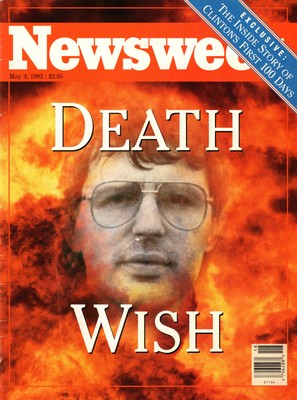
Cover of Newsweek, May 3, 1993. | |
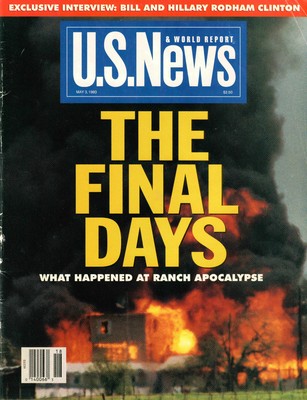
Cover of U.S.News & World Report, May 3, 1993 |
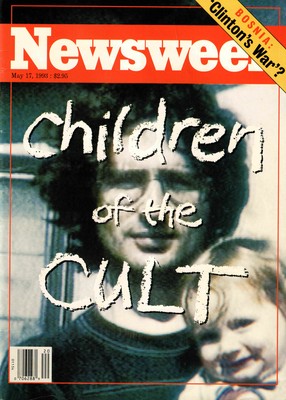
Cover of Newsweek, May 17, 1993 | |